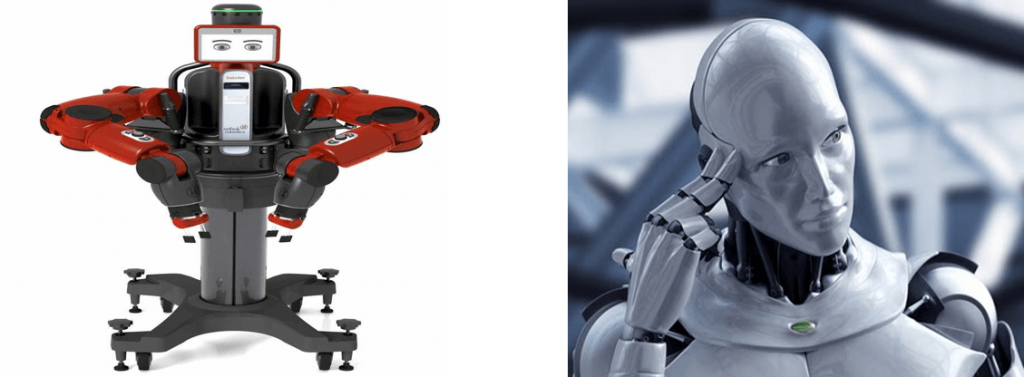At the end of this lesson-
- 1. You will be able to explain Artificial Intelligence.
- 2. You will be able to explain several expert systems and their uses.
- 3. You will be able to explain Robotics.
- 4. You will be able to describe different parts of a robot.
- 5. You will be able to describe the characteristics and uses of robot.
- 6. You will be able to differentiate expert system and robot.
Go for Bangla Version
Artificial Intelligence:
Artificial Intelligence is composed of two words Artificial and Intelligence, where Artificial defines “man-made,” and intelligence defines “thinking power”, hence AI means “a man-made thinking power.”
Artificial intelligence (AI) refers to the simulation of human intelligence in machines that are programmed to think like humans and mimic their actions.
In other words, Artificial intelligence is the ability of a computer-controlled system to perform tasks like a human can perform tasks.
The father of Artificial Intelligence, John McCarthy
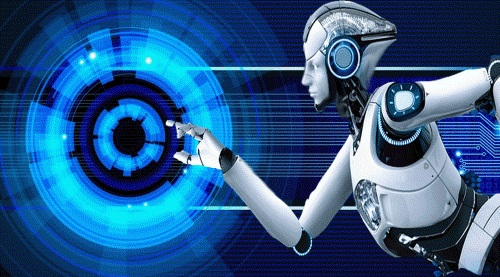
Artificial Intelligence is not just a part of computer science even it’s so vast and requires lots of other factors which can contribute to it. To create the AI first we should know that how intelligence is composed, so the Intelligence is an intangible part of our brain which is a combination of Reasoning, learning, problem-solving perception, language understanding, etc.
To achieve the above factors for a machine or software Artificial Intelligence requires the following discipline:
- Mathematics
- Biology
- Psychology
- Sociology
- Computer Science
- Neurons Study
- Statistics
The goals of artificial intelligence include learning, reasoning, and perception. The ideal characteristic of artificial intelligence is its ability to rationalize and take actions that have the best chance of achieving a specific goal.
Examples of machines with artificial intelligence include computers that play chess and self-driving cars. Each of these machines must weigh the consequences of any action they take, as each action will impact the end result. In chess, the end result is winning the game. For self-driving cars, the computer system must account for all external data and compute it to act in a way that prevents a collision.
Artificial intelligence is applied in Expert System, Robotics, Neural Networks, Fuzzy Logic, Natural Language Processing etc.
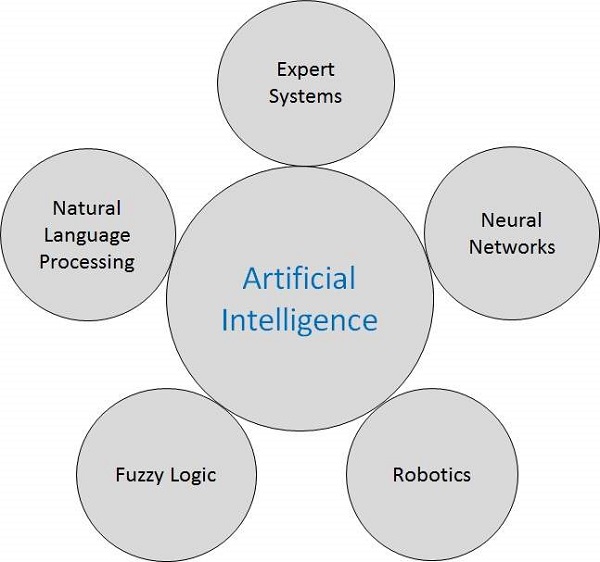
Fig: Application of Artificial intelligence
Several programming languages like LISP, CLISP, PROLOG, C/C++, JAVA are used in implementing Artificial intelligence in Expert System, Robotics, Neural Networks, Fuzzy Logic, Natural Language Processing etc.
Categorization of Artificial Intelligence:
Artificial intelligence can be divided into two different categories: weak and strong.
Weak artificial intelligence: Weak artificial intelligence embodies a system designed to carry out one particular job. Weak AI systems include video games such as the chess example from above and personal assistants such as Amazon’s Alexa and Apple’s Siri. You ask the assistant a question, it answers it for you.
Expert System:
The expert systems are the computer applications developed to solve complex problems in a particular domain, at the level of extra-ordinary human intelligence and expertise.
Characteristics of Expert Systems:
- High performance
- Understandable
- Reliable
- Highly responsive
Components of Expert Systems:
The components of ES include −
- Knowledge Base
- Inference Engine
- User Interface
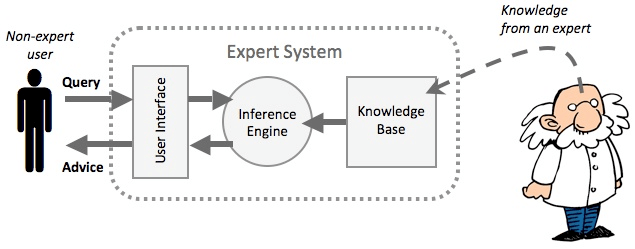
Knowledge Base: It contains domain-specific and high-quality knowledge. Knowledge is required to exhibit intelligence. The success of any ES majorly depends upon the collection of highly accurate and precise knowledge.
Inference Engine: Use of efficient procedures and rules by the Inference Engine is essential in deducting a correct, flawless solution. In case of knowledge-based ES, the Inference Engine acquires and manipulates the knowledge from the knowledge base to arrive at a particular solution.
User Interface: User interface provides interaction between user of the ES and the ES itself. It is generally Natural Language Processing so as to be used by the user who is well-versed in the task domain. The user of the ES need not be necessarily an expert in Artificial Intelligence.
Capabilities of Expert Systems:
The expert systems are capable of −
- Advising
- Instructing and assisting human in decision making
- Demonstrating
- Deriving a solution
- Diagnosing
- Explaining
- Interpreting input
- Predicting results
- Justifying the conclusion
- Suggesting alternative options to a problem
Several expert systems and their functions:
Deep blue: Judge of chess
Internist: Medical officer
Mycin and Cadulus: Medical officer
Mycsyma: Solve mathematical problem
Dendral: Teach programming
Prospector: Search mineral and mining
Benefits of Expert Systems:
Availability − They are easily available due to mass production of software.
Less Production Cost − Production cost is reasonable. This makes them affordable.
Speed − They offer great speed. They reduce the amount of work an individual puts in.
Less Error Rate − Error rate is low as compared to human errors.
Reducing Risk − They can work in the environment dangerous to humans.
Steady response − They work steadily without getting motional, tensed or fatigued.
Robotics:
Robotics is the branch of technology that deals with the design, construction, operation, and application of robots.
Robot:
Robot is one kind of computer-controlled electro-mechanical machine designed to execute one or more tasks automatically with speed and precision. It is designed based on artificial Intelligence that can perform tasks like human and controlled by computer program.
Components of a Robot:
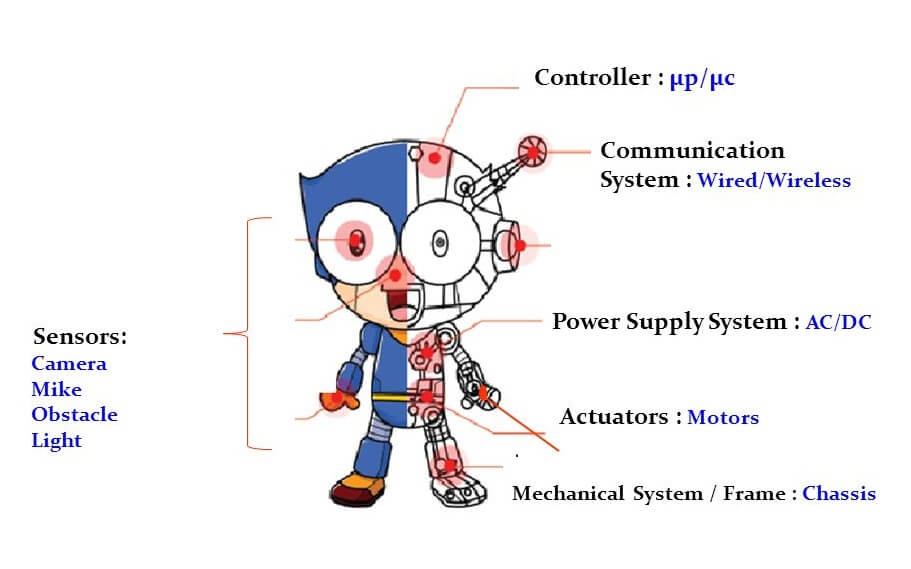
Robots are constructed with the following −
Power Supply − The robots are powered by batteries, solar power, hydraulic, or pneumatic power sources.
Actuators − They convert energy into movement.
Electric motors (AC/DC) − They are required for rotational movement.
Pneumatic Air Muscles − They contract almost 40% when air is sucked in them.
Muscle Wires − They contract by 5% when electric current is passed through them.
Piezo Motors and Ultrasonic Motors − Best for industrial robots.
Sensors − They provide knowledge of real time information on the task environment. Robots are equipped with vision sensors to be to compute the depth in the environment. A tactile sensor imitates the mechanical properties of touch receptors of human fingertips.
Characteristics of robot:
1. A robot is a machine that gathers information about its environment and uses that information to follow instructions to do work.
2. A robot has to be artificial which means it is made by a human.
3. They also have to be controlled by a computer and it has to sense its surrounding environment.
4. The robot has to be able to perform actions and movements.
5. Robots were made to the jobs that were too dangerous, dirty, or too delicate for humans to handle alone.
6. Some robots were made to do the jobs that people were just too lazy to do, or just too boring.
7. The robot can work tirelessly.
Applications of Robots:
The robots has been instrumental in the various domains such as −
Industries − Robots are used for handling material, cutting, welding, color coating, drilling, polishing, etc.
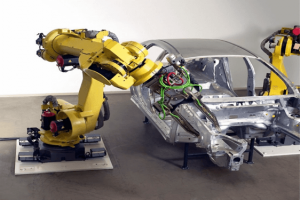
Military − Autonomous robots can reach inaccessible and hazardous zones during war. A robot named Daksh, developed by Defense Research and Development Organization (DRDO), is in function to destroy life-threatening objects safely.
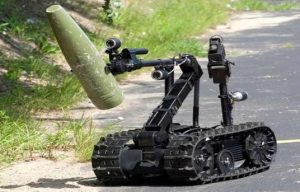
Medicine − The robots are capable of carrying out hundreds of clinical tests simultaneously, rehabilitating permanently disabled people, and performing complex surgeries such as brain tumors.
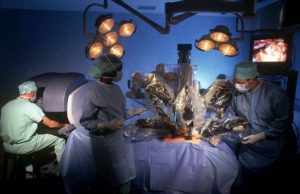
Exploration − The robot rock climbers used for space exploration, underwater drones used for ocean exploration are to name a few.
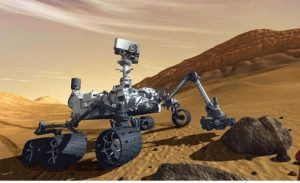
Entertainment − Disney’s engineers have created hundreds of robots for movie making.
Lesson Evaluation-
Knowledge Based Questions:
- a. What is artificial intelligence?
- a. What is expert system?
- a. What is robotics?
- a. What is robot?
Comprehension Based Questions:
- b. “Machine can work automatically”- Explain.
- b. Explain the technology used in risky task.
- b. “It is convenient to use machine in risky task”-Explain.
- b. Explain the role of artificial intelligence in robot.
- b. “Artificial Intelligence is an important branch of Computer Science”-Explain.
- b. How Artificial Intelligence is related to medical service? –Explain.
- b. “Robot is a program controlled machine”-Explain.
- b. How robot makes humans work easier? -Explain.
Creative Questions:
Read the stem and answer the question:
A world-class industrial factory is planned to be established in the near of the capital of Bangladesh, where the actuator will help the country to become better and economically self-sufficient by producing the necessary computer equipment efficiently. The skilled programmers of the institute will set up a simulated environment and arrange for the visitors to visit various sights of the city at home.
c) Identify and explain the technology used in the industrial factory.
Read the stem and answer the question:
An electric short circuit in a slum of the capital caught fire. Fire service personnel arrived shortly , but the fire was so heavy and they could not enter. As a result, they used a special device to control the fire.
c) Explain the device mentioned to the stem.
d) Analyze the impact of the device mentioned in the stem.
Multiple Choice Questions:
1. What is the technology to convey human thoughts through machines?
a) Biometrics b) Bioinformatics c) Artificial intelligence d) Virtual reality
2. The artificial intelligence has been added to which generation of computers?
a) third b) fourth c) fifth d) sixth
3. Who first introduced the word ‘Artificial intelligence’?
a) Jack Williamson b) Marshall Mcluhan c) John McCarthy g) Karel Capek
4. In which case is the actuator used?
a) Biometrics b) Bioinformatics c) Robotics d) Virtual Reality
5. How many degrees of rotation can the robot for work?
a) 90 b) 180 c) 270 d) 360
6. Features of Robots –
i. It is perfectly operational ii. It can work tirelessly iii. It is slow
Which one is correct?
a) i & ii b) i & iii c) ii & iii d) i, ii & iii
7. Robots are used –
i. In housework ii. In planning iii. In the inner workings of mining
Which one is correct?
a) i & ii b) i & iii c) ii & iii d) i, ii & iii
Read the stem and answer questions no. 8 & 9:
During the inauguration of the digital fair, the Prime Minister had a lively conversation with the Humanoid called Sofia.
8. What is the point indicated by the stem?
a) Biometrics b) Nanotechnology c) Robotics d) Virtual Reality
9. As a result of the technology used in the stem-
a) Children’s intelligence will develop
b) Human activity will increase
c) Human values will increase
d) Lower the factory cost
Read the stem and answer questions No. 10 & 11:
Recently, Shamim, a student of computer science at the Islamic University, has long researched and invented a machine that can move in high and low places and can send video.
10. What technology did Shamim use to make the machine?
a) Biometrics b) Nanotechnology c) Robotics d) Virtual Reality
11. Shamim’s device can be used in-
i. Industrial factories ii. Medical field iii. House management
Which one is correct?
a) i & ii b) i & iii c) ii & iii d) i, ii & iii
12. Application Areas of Artificial Intelligence are-
i. Expert System ii. Fuzzy logic iii. Learning system
Which one is correct?
a) i & ii b) i & iii c) ii & iii d) i, ii & iii
Written by,
- Mizanur Rahman (Mizan)
- Lecturer of ICT, Shaheed Bir Uttam Lt. Anwar Girls’ College , Dhaka Cantonment
- Author at www.edupointbd.com
- Software Engineer at mands IT
- Former Lecturer of ICT, Cambrian College, Dhaka
- Email: mizanjust@gmail.com
- Cell: 01724351470

